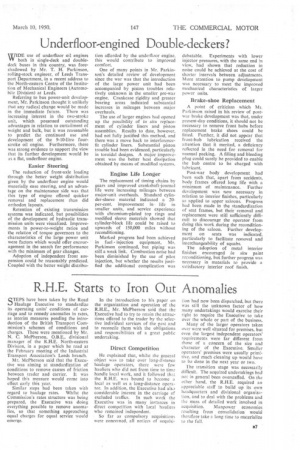Underfloor-engined Double-deckers?
Page 41

If you've noticed an error in this article please click here to report it so we can fix it.
WIDE use of underfloor oil engines both in single-deck and doubledeck buses in this country, was foreshadowed by Mr. T. H. Parkinson, rolling-stock engineer, of Leeds Transport Department, in a recent address to the North-eastern Centre of the Institution of Mechanical Engineers (Automobile Division) at Leeds.
Referring to bus power-unit development, Mr. Parkinson thought it unlikely that any radical change would be made in the immediate future. There was increasing interest in the two-stroke unit, which possessed outstanding advantages in relation to curtailment of weight and bulk, but it was reasonable to predict the continued use and development of the 9-10-litre fourstroke oil engine. Furthermore, there was strong evidence to support the view that its further development would be as a flat, underfloor engine.
Easier Steering
The reduction of front-axle loading through the better weight distribution given by the underfloor engine would materially ease steering, and an advantage on the maintenance side was that this type of engine offered quicker removal and replacement than did orthodox layouts.
Retention of existing transmission systems was indicated, but possibilities of the development of hydraulic transmission units were visualized. Improvements in power-to-weight ratios and the relation of torque governors to the characteristics of the large power unit were factors which would offer encouragement in the search for performance with the minimum of gear changes.
Adoption of independent front suspension could be reasonably predicted. Coupled with the better weight distribu
tion afforded by the underfloor engine, this would contribute to improved comfort.
One of many points in Mr. Parkinson's detailed review of development since the war was that the introduction of the large power unit had been accompanied by piston troubles relatively unknown in the smaller pre-war engine, Crankcase rigidity and greater bearing areas indicated substantial increases in mileages between major overhauls.
The use of larger engines had opened up the possibility of in situ replacement of cylinder liners and piston assemblies. Results to date, however, had not fully justified this method, and there was a move back to interferencefit cylinder liners. Substantial piston trouble had been evidenced, particularly in toroidal designs. A major improvement was the better heat dissipation obtained by means of modified systems.
Engine Life Longer
The replacement of timing chains by gears and improved crankshaft-journal life were increasing mileages between major-unit overhauls. Standard cylinder-sleeve material indicated a 20per-cent. improvement in life in smaller units, and service experience with chromium-plated top rings and modified sleeve materials showed that cylinder-block life could be raised to upwards of 150,000 miles without reconditioning.
Marked progress had been achieved in fuel injection equipment, Mr. Parkinson continued, but piping was still a weak link. Combustion noise had been diminished by the use of pilot injection, but whether the results justified the additional complication was debatable. Experiments with lower injector pressures, with the same end hi view, had shown that reduction in noise could be achieved at the cost of shorter intervals between adjustments. More attention to pump development was necessary to meet the improved mechanical characteristics of larger power units.
Brake-shoe Replacement
A point of criticism which Mr. Parkinson raised in his review of postwar brake development was that, under present-day conditions, it should not be necessary to remove front hubs before replacement brake shoes could be fitted. Further, it did not, appear that front-hub lubrication received the attention that it merited, a deficiency reflected in the need for removal for manual packing. A filling and bleeding plug could surely be provided to enable the hub centre to be charged with I uhricant.
Post-war body development had been such that, apart from accidents, body frames offered long life with a minimum of maintenance. Further development was now necessary in relation to interior finishes, particularly as applied to upper saloons. Progress had been made in the standardization of seat frames, but their removal and replacement were still sufficiently difficult to discourage the operator from doing this work during the reconditioning of the saloon. Further development on seats was indicated, particularly to facilitate removal and interchangeability of squabs.
The adoption of metal interior finishes encouraged in situ paint reconditioning, hut further progress was necessary in materials to provide a satisfactory interior roof finish.




















































































